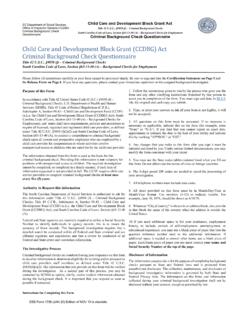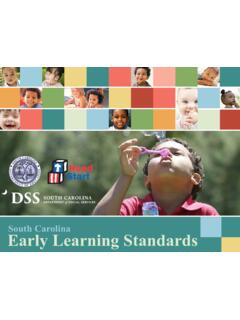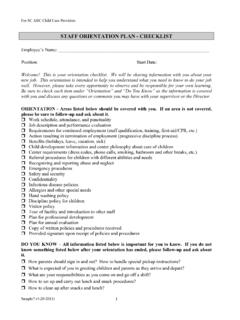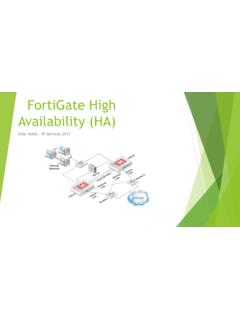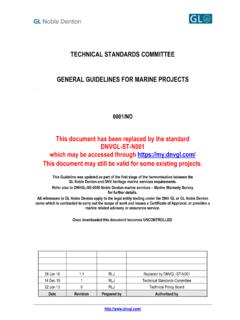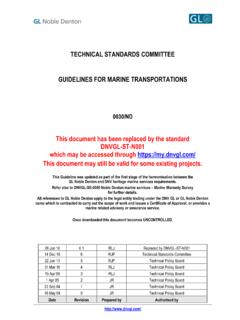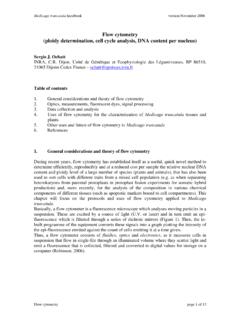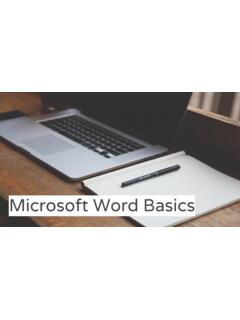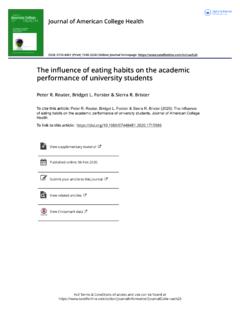Transcription of PRESCHOOL MATERIALS GUIDE - SC Child Care
1 P R E S C H O O L M AT E R I A L S G U I D E. Herman T. Knopf & Kerrie L. Welsh Published February 2010. Table of Contents Introduction ..1. The PRESCHOOL Environment ..3. Learning Centers ..4. Block Center ..7. Dramatic Play Area ..9. Art Center ..12. Manipulatives Center ..15. Cozy Book/Library Center ..17. Science/Discovery Center ..19. Music and Movement Center ..21. Sand and Water Center ..23. Computer Centers ..25 This document is meant to support the thoughtful selection of equipment and MATERIALS as part of efforts to increase the quality Outdoor Play.
2 27 of childcare programming experienced by young children in South Carolina. The document is being field-tested to solicit feedback from Notes ..29 Early Childhood Professionals from across the state. Please send comments and suggestions to the: References ..30. USC Child Development Research Center APPENDIX I | (803) 777-2136. Acknowledgments South Carolina is appreciative of the American Recovery and Reinvestment Act (ARRA) funds that have made this initiative to upgrade the MATERIALS and equipment for South Carolina Child care providers (centers, family homes, and group homes) a reality.
3 The ARRA funds were made available to the South Carolina Department of Social Services (SCDSS), administrator for the Child Care and Development Fund (CCDF) under the leadership of Leigh W. Bolick. To assure the developmental appropriateness and quality of the GUIDE , SCDSS. sought the early childhood leadership and management of the College of Education, University of South Carolina. This PRESCHOOL MATERIALS GUIDE is designed to assist Child care providers in selecting high quality MATERIALS for their classrooms, not only for the ARRA funded grants in the short term, but also for long-term planning to help GUIDE and prioritize future purchases.
4 It is a tool that can help make the most of current investments as well as those in the future. The PRESCHOOL MATERIALS GUIDE is the result of careful consideration of South Carolina's Child care regulatory standards, the South Carolina ABC Child Care Program Standards, and the Environment Rating Scales (ERS) used at the different quality levels of the South Carolina ABC Child Care Program. The South Carolina Good Start Grow Smart Early Learning Standards were reviewed and incorporated as well. The PRESCHOOL MATERIALS GUIDE was modeled after an ABC Child Care Program GUIDE authored by the late Saundra V.
5 Ground, Herman T. Knopf, , and Kerrie L. Welsh, , authors and editors of this GUIDE , wish to thank Carol Perkins, , Angela Baum, , Nancy Freeman, , Jillian Peltzman, Elyse Osborne, and Rebecca Horsey for their work in support of this document. Thanks are also given to Mac Brown, who provided some of the photographs included in the GUIDE . Review and comments by the following staff of the South Carolina ABC Child Care Program are greatly appreciated: Beverly B. Hunter, ; Noelle P. McInerney, ; Myrna S. Turner, ; Cynthia P.
6 Moyd, ; Ginger Miller, and Melissa Heston. Reviews from Richard Knight and Bob Howard at South Carolina Child Care Licensing are also greatly appreciated. Graphic design by Michelle M. Moshinskie. Introduction MATERIALS List This prioritized list includes the basic MATERIALS needed in the The choices for designing a quality childcare program for young learning center as well as accessories that will expand and extend children can be overwhelming for a childcare professional, especially children's interest and discovery.
7 When working with a limited budget. This GUIDE has been created to help you to design a high-quality environment for young children, Brand names are sometimes used to describe items but are not meant while making the best choices for your budget. While purchasing the to be exclusive. Generic copies of those items may be acceptable correct MATERIALS is not sufficient supervision and interaction with with the following precaution: MATERIALS should be durable enough interested adults is necessary for children to make full use of them.
8 For daily use by young exuberant learners. Through intentional teaching, MATERIALS can be used for both Child - guided experiences and adult-guided experiences. MATERIALS need to be: interesting to children, sturdy, age appropriate, offer variety and The Shopping List choice, and be arranged in such a way as to encourage independence Included at the end of this GUIDE is a classroom inventory checklist and creativity. that can be used to help you create and prioritize your MATERIALS and equipment shopping list. First you will use the list to conduct How This Document is Organized a classroom inventory, identifying all of the items on the list that you currently have and their present condition (like new, good, in In this GUIDE , we look at the whole classroom to identify and describe need of repair).
9 Then, review the list to determine if there are any basic equipment and MATERIALS that should be in classrooms for MATERIALS that you either need to replace or add to your classroom. PRESCHOOL aged children. The following sections of this GUIDE provide There are quantities listed for each item on the list. These are based descriptions of common learning centers found in early childhood on a class size of 20 children. Use your professional judgment when classrooms. The description of each learning center includes these determining the quantities of MATERIALS you will need based on the features: number of children enrolled in your class.
10 Development & Learning This section describes the developmental domains that are likely to be Fundamentals addressed as a result of Child and teacher engagement in the center. While this document focuses on the MATERIALS and equipment that Notes have been included to help you connect children's learning in should be in the learning environment, they are no replacement for each center with the South Carolina Good Start Grow Smart Early high quality teacher/ Child interaction. The way in which caregivers Learning Standards.
